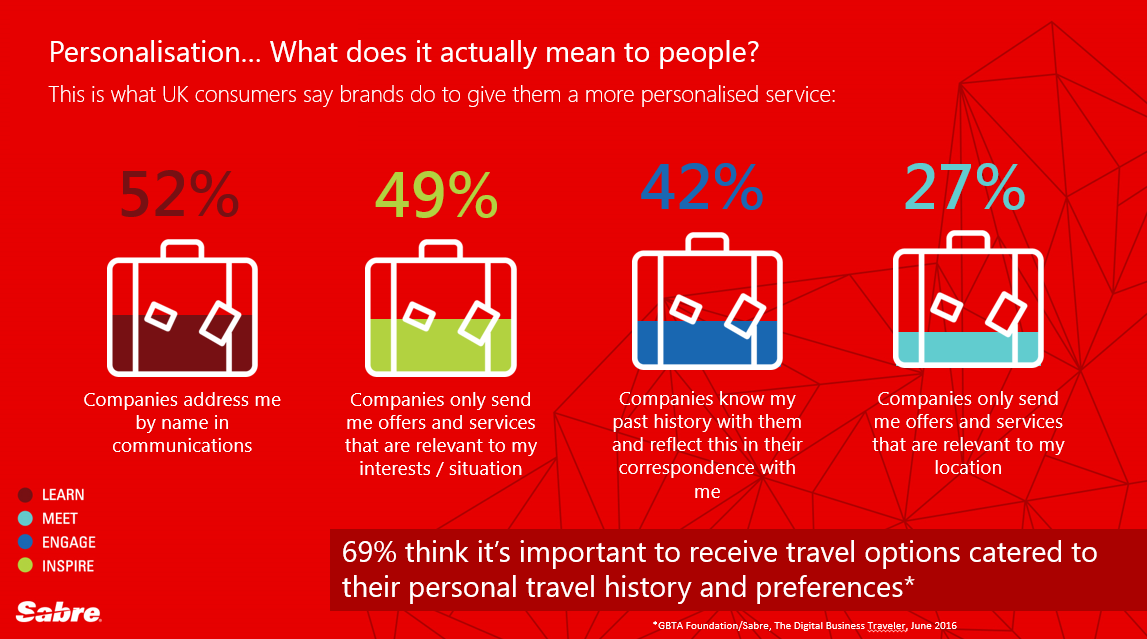BY
NICK VIVION
Personalization is a familiar buzzword in many industries. The concept is often associated with retail and travel, as each are incredibly personal and data-rich. The promise of delivering highly targeted offers to consumers in real-time is especially valuable in retail settings, where the path-to-purchase is filled with distractions and competition. Either competitors entice consumers out of one purchase funnel into another, or customers are pulled away by one of the endless digital distractions.
In travel, the focus is not just on converting a looker to a booker. It’s also about personalizing the shopping experience so that the traveler finds what they’re looking for as fast and accurately as possible. This then extends to the actual experience of travel — the purchase process is just the first stage in the traveler’s journey. This point marks the first of many more opportunities to personalize the traveler’s experience.
Defining personalization in travel
For the UK consumer, there are some important ways that brands can acknowledge the relationship with personalized service. Namely, address the consumer directly in communications and then send only targeted, relevant offers. Per soon-to-be released research, a large percentage of respondents expect past behavior reflect in communications. The expectation is that companies have information on past behavior and should use those historical customer profiles to build personalized offers.

While this data focused on the UK, it’s safe to extrapolate similar results in other Western cultures. The appreciation of personalized experiences is high, and the desire to share data comes with an important caveat: provide true value to the individual consumer and not only for the business pushing the offer. In fact, new GBTA research found that 69% of travelers want personalized travel options based on previous behaviors.
“Know thy customer” is the new mantra, and one that’s being repeated by the customer over and over. It’s significant that a clear majority of consumers express a preference that also makes travel companies more money through traveler loyalty to better experiences. Amsterdam-based CitizenM’s Lennert de Jong knows this value well — over a decade, his brand has fostered a reputation for knowing the customer:
We have invested a lot of money and energy in creating a knowledge layer. We worked to integrate every system so we could make the process more seamless. No more wondering why a system would not respond to another. We now have knowledge on all the actions that happen at both the system AND user level. You put your room on 18 degrees when you are at citizenM. On your next check-in, why would we give you a room that is 24 degrees?
This is seamless personalization.
In travel, personalization promises that customer profiles adapt according to past behavior. Personalization is not just the outcome experienced by the traveler but also the real-time process by which travel brands capture data and leverage it to enhance hospitality. Yes, it’s the right offer at the right time to the right person — but it’s also a reliable technology platform with intelligent processes to consistently deliver.
Personalization has always been a core promise of hospitality — greeting a guest by name or remembering an allergy. The mobile revolution has brought Big Data into every decision, challenging the industry to evolve its approach to include data when crafting the guest experience. CitzenM’s de Jong emphasizes that technology can work well within the industry, but not when it’s used poorly:
I dislike the scriptedness of it. I say your name 3 times — without ever meeting you before — and I’ve achieved a level of personalization? I don’t believe that.
I believe in humanization. We are in a people business, which means we can have humans act like humans to others, while computers take care of some of the processes. They are better at that, anyhow!
Most important is to keep sight on the ultimate promise of hospitality: the warmth, kindness and congeniality that defines a memorable experience just as much as an invisible data profile.
 While this data focused on the UK, it’s safe to extrapolate similar results in other Western cultures. The appreciation of personalized experiences is high, and the desire to share data comes with an important caveat: provide true value to the individual consumer and not only for the business pushing the offer. In fact, new GBTA research found that 69% of travelers want personalized travel options based on previous behaviors.
“Know thy customer” is the new mantra, and one that’s being repeated by the customer over and over. It’s significant that a clear majority of consumers express a preference that also makes travel companies more money through traveler loyalty to better experiences. Amsterdam-based CitizenM’s Lennert de Jong knows this value well — over a decade, his brand has fostered a reputation for knowing the customer:
While this data focused on the UK, it’s safe to extrapolate similar results in other Western cultures. The appreciation of personalized experiences is high, and the desire to share data comes with an important caveat: provide true value to the individual consumer and not only for the business pushing the offer. In fact, new GBTA research found that 69% of travelers want personalized travel options based on previous behaviors.
“Know thy customer” is the new mantra, and one that’s being repeated by the customer over and over. It’s significant that a clear majority of consumers express a preference that also makes travel companies more money through traveler loyalty to better experiences. Amsterdam-based CitizenM’s Lennert de Jong knows this value well — over a decade, his brand has fostered a reputation for knowing the customer: